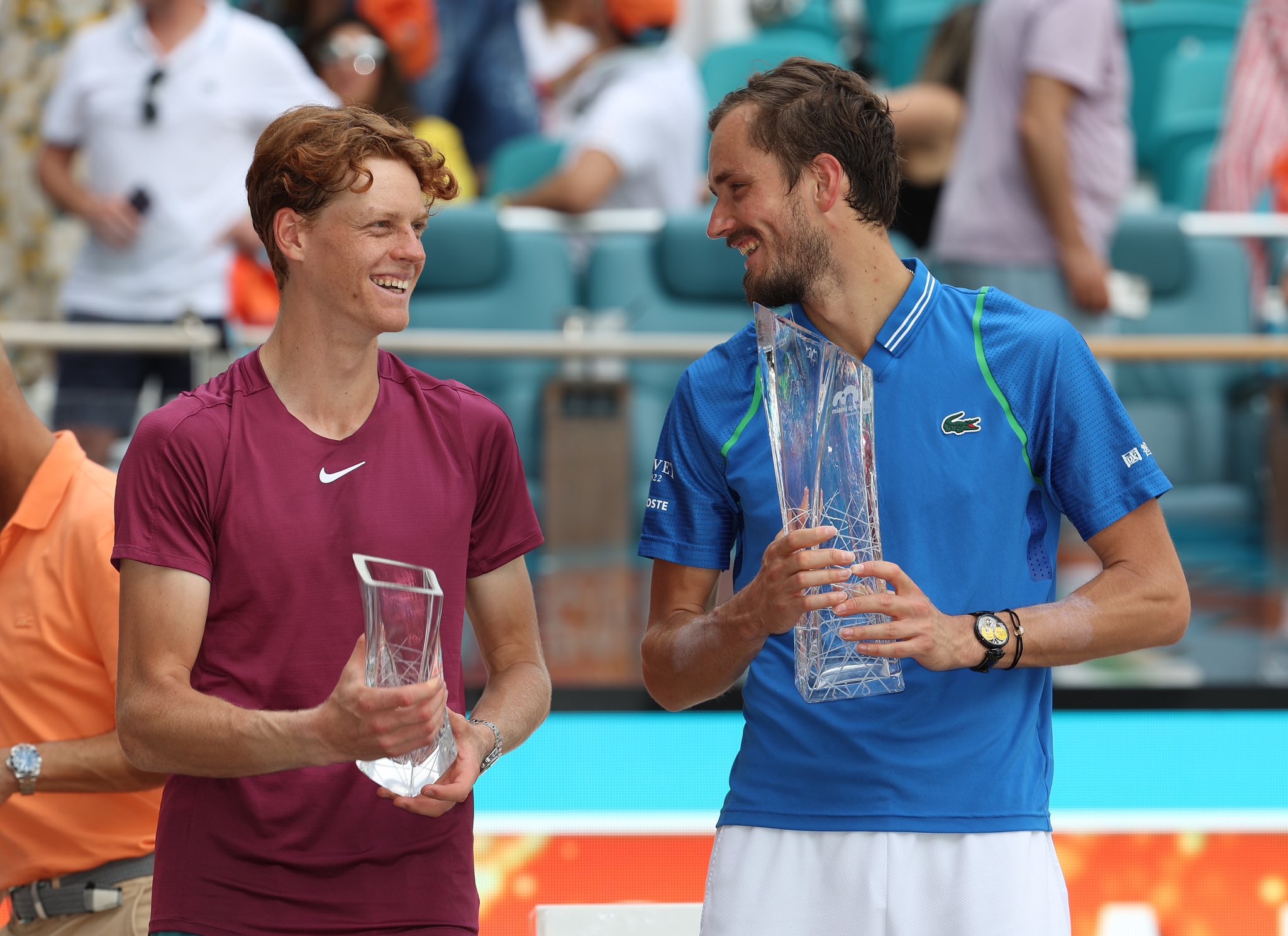Given the occasion, Ubitennis has provided an analysis of the Miami final, in which Jannik Sinner was unable to bring out his best and was crushed by Medvedev who was able to stay calm and stick to his plan A. Unlike the Rotterdam final, in which Jannik was able to put pressure on the Russian in extended rallies during the first set, Sunday’s match was completely one-sided.
General summary: once again, we take the opportunity to present our own analysis of the main dimensions of the match with respect to serve and return:
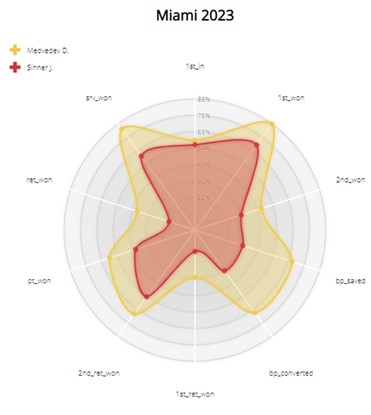
The data is as follows (all values are expressed in percentages, along the axes of the radar graph):
1st_in -> first serves in play 1st_won -> points won on first serve 2nd_won -> points won on second serve Bp_saved -> break points saved Bp_converted -> break points converted 1st_ret_won -> points won on opponent’s first serve return 2nd_ret_won -> points won on opponent’s second serve return Pt_won -> points won Ret_Won -> points won on return Srv_won -> points won on serve
It is clear that under all the main serve metrics, Jannik was at a disadvantage and was more or less dominated. If we compare Sunday’s representation with that of Rotterdam, we can see that the step back can be mainly noticed in the performance relative to the second serve. While in the Netherlands Sinner was competitive on rallies, forcing Medvedev to change his tactics, in Miami he was at a disadvantage even in this situation.

Serve direction: based on the charting provided at the end of the article, we have graphically represented the serving directions chosen by the two players in detail:
The graphs are read as follows: the blue arrows represent the direction of serves from the ad side (with players serving from right to left). The yellow arrows represent the direction of serves from the deuce side (with players serving from left to right). The thickness of the arrow visually indicates how much a particular direction was chosen compared to the other. The values are expressed in percentage, with the service area divided into 6 areas:
Serves from the ad side Wide serves Body serves Serves on the T Serves from the deuce side Wide serves Body serves Serves on the T Let’s see once again how the choices were made and what has changed between Rotterdam and Miami:
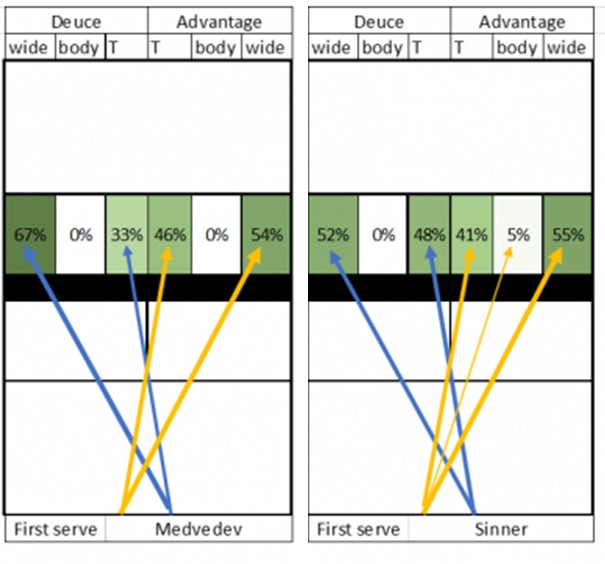
Distribution of serving direction on the first serve for the Rotterdam final 2023
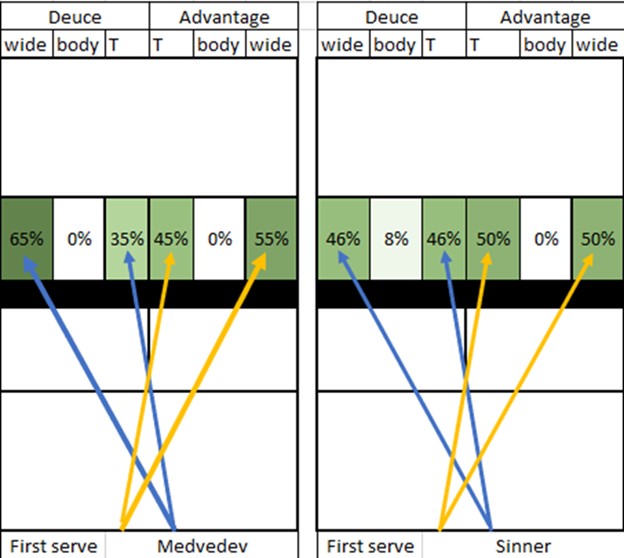
Distribution of serving direction on the first serve for the Miami final 2023
It’s impressive to see how in Medvedev’s case the choices were almost replicated to the millimetre, while Sinner tried to vary more, distributing more evenly and using less the slice serve out wide, which had still brought good results in Rotterdam.
In terms of the efficiency of these choices, let’s continue the comparison with Rotterdam.
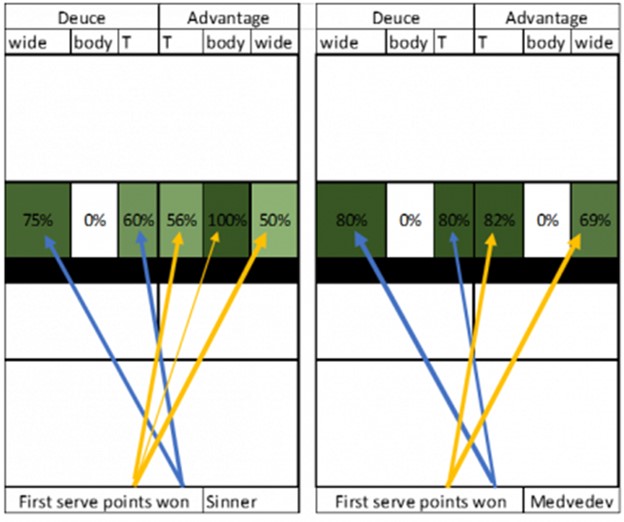
Distribution of points won on first serve during the Rotterdam Final 2023
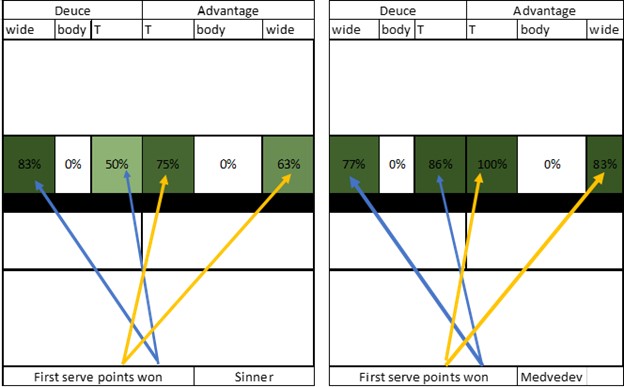
Distribution of points won on first serve during the Rotterdam Final 2023
This is perhaps the data that struck us the most: compared to Rotterdam, there seems to have been a deliberate choice to use less slice serves on the wide side in the deuce court. However, this tactical choice, just like in Rotterdam, proved to be the most profitable for Sinner. Since we now lack a counter-test, it would be interesting to see in a future match on a fast surface what would happen if Medvedev were served slice serves systematically (say, over 75% of the time). Perhaps, despite his great recovery skills, having to handle so much court coverage on the opponent’s serve could be too much even for him. On the other hand, the choice to shuffle the cards more seems to have paid off for Sinner on the advantage side. On Medvedev’s side, the same invincibility was observed when the Russian had put in his first serves.
Performance on return: both players were extremely conservative, as they rarely tried to be incisive on their opponent’s second serve. As for the return position, the Russian positioned himself as usual on the backcourt when returning the opponent’s first serve, and the approach was not very different on the second serves. In this case, we do not report the data for Rotterdam for the Russian as they are quite overlapping.
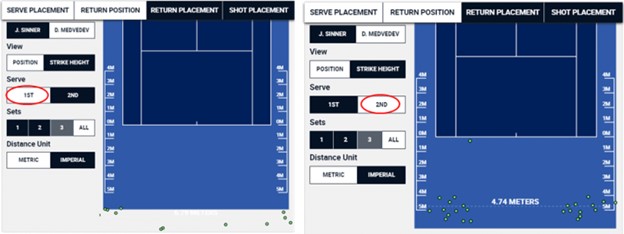
Return position – Daniil Medvedev MIAMI FINAL 2023
In Sinner’s case, the comparison with Rotterdam is interesting because we can notice some significant adjustments.
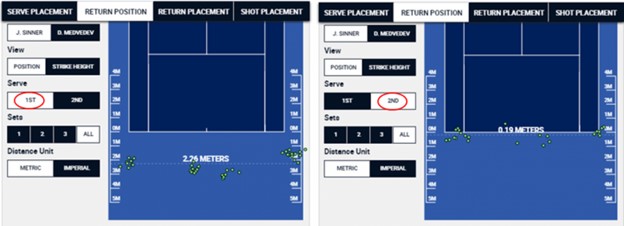
Return position – Jannik Sinner ROTTERDAM FINAL 2023
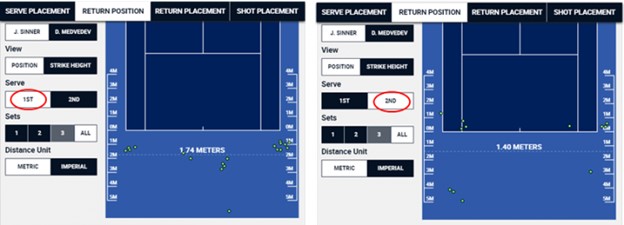
Return position – Jannik Sinner MIAMI FINAL 2023
On the return to Medvedev’s second serve, the Italian stayed much further back, trying to start the rally and give himself more time against the Russian’s unpredictable second serves. Whether this tactic paid off today is difficult to say as second serve returns are typically the battleground of attrition where rallies are likely to extend beyond 5 shots, and today Jannik showed clear physical limits. It’s a shame because there remains a question mark over the effectiveness of a deliberate tactical choice.
Length of rallies: this is where the difference with Rotterdam is most noticeable. While in the Netherlands, the first set was a rumination of prolonged rallies in which Jannik often came out on top, today there was no particular contest.
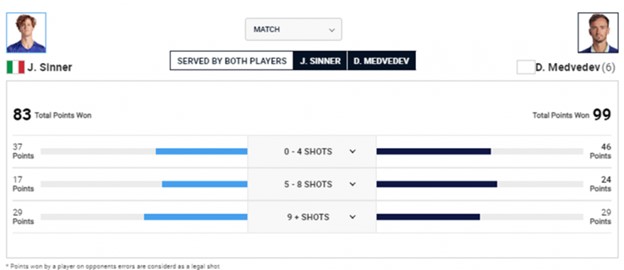
Distribution of rallies by number of exchanged shots – ROTTERDAM FINAL 2023

Distribution of rallies by number of exchanged shots – MIAMI FINAL 2023
The prevalence of Medvedev on short exchanges, although not spectacular, remains. While on prolonged exchanges, the Russian literally set the table and feasted on a Sinner who, as he expressed during the awards ceremony, was not in the best physical condition. However, as always, the Italian was good at not giving up and trying to fight with what he had.
Management of pressure situations: one of the great myths in tennis is that of mental solidity and the management of important points; in tennis, it’s known that points are not counted but weighed, so we asked ourselves a question: is it true that certain players are able to raise their level and serve better at certain moments, more frequently than usual? We then looked at what Jannik and Daniil did today: the percentage of first serves in the court for the two finalists was as follows:
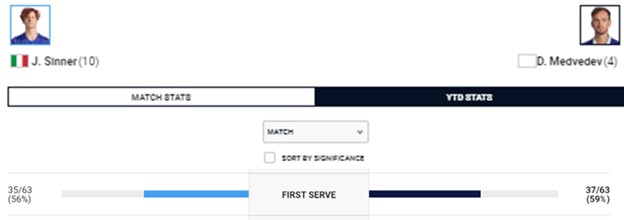
General % of first serves in play – MIAMI FINAL 2023
Afterwards, we looked at what happened in some game situations that we considered “Pressure Points”: in other words, every time the score was at Break Point or 40-40, we considered that point to be a “delicate” point and we crossed the data. The result? In the end, the sample largely reflects the general population. Today we didn’t see many situations in this aspect that were much above or much below average.
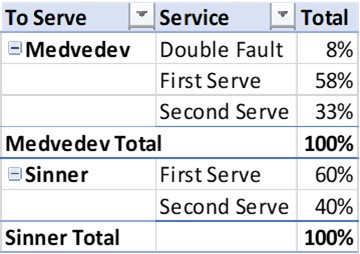
% of first serves in play in pressure situations – MIAMI FINAL 2023
It’s interesting to see the choices the two players made in these crucial moments on their first serves. The classic question that inevitably crosses a player’s mind in these high-pressure situations is: where to serve? which direction to choose? Especially when they were playing on the advantage side, they tried to mix things up a bit: Medvedev, who had normally served only 55% of first serves in “pressure point” situations, went wide in 75% of cases. Sinner, on the other hand, always went down the middle when he found himself playing heavy shots from the advantage side!
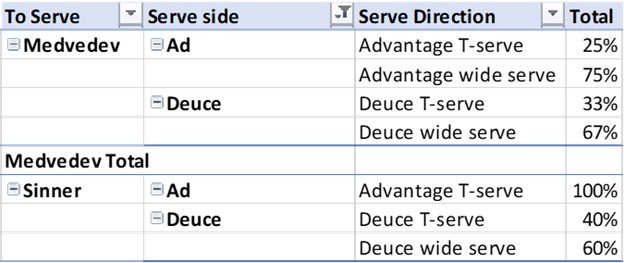
Distribution % of serve direction in play during pressure situations – MIAMI FINAL 2023




